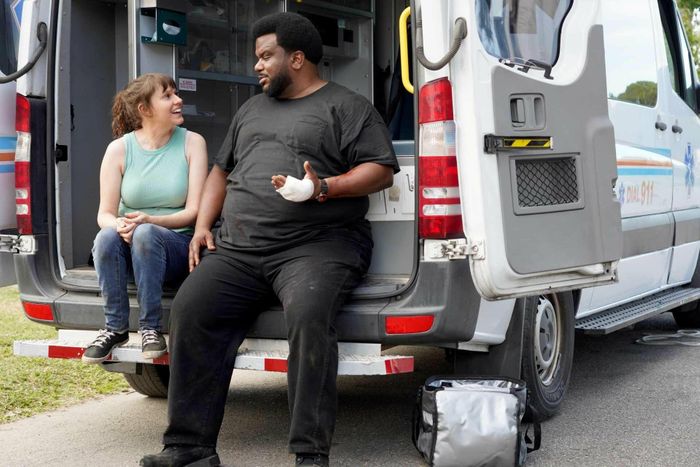
In a 2019 Smithsonian magazine feature titled “The Snakes That Ate Florida,” Ian Frazier went long on how the Everglades has been overrun by Burmese pythons, imported as exotic pets and then abandoned once they grew past the cute-baby stage into the 200-pound, “will eat anything they can get their mouths around” stage. “No one knows how many pythons are out there now. Estimates run from 10,000 to perhaps hundreds of thousands,” Frazier writes. The snakes are out of control, and in its smartest moments, the class-conscious Peacock series Killing It links the insatiability of a species with no natural predators and no sense of when enough is enough to capitalism as a failed system, run by one-percenters, influencers, and racists who also have no natural predators and no sense of when enough is enough.
It’s an abstract comparison, but Killing It draws incisive observations out of its first absurd setup — a hunt to kill those pythons, with a $20,000 reward — and the increasingly silly ones that follow over its ten-episode first season, all of which is available to stream today. In nearly every episode, a working-class protagonist made hapless by the extreme gaps in our economy is paired with someone whose schemes and lies have secured them success. An immigrant working nine jobs to get by is hired to impersonate a wealthy woman trying to scam the IRS; a scrappy entrepreneur is threatened by a real-estate mogul whose entire family is in on a “pay thousands to learn our business secrets” scheme; an aspiring influencer is injured when a pair of Jesus-loving YouTube pranksters set off a land mine for their own, far more popular channel.
There is a certain redundancy to this format, but Killing It’s point about the insurmountable gap between predators and prey is both consistent and darkly amusing, with supporting turns from John Early, D’Arcy Carden, and Tim Heidecker helping with the latter. Surrounding this observation is a fair amount of plot — arguably too much — and jokes that are often broad, with a focus on heightened emotionality, elevated tone, and mocking Florida. (“Tanning salon, bong store, and a Boost Mobile” are described as the state’s definitive trifecta.) But Killing It secures watchability and relevance through its The Good Place–evoking core questions: If the odds are stacked against us, does individual responsibility become irrelevant? What is the purpose of morality in a seemingly predetermined world? What is the tangible benefit of being good? There are answers to those questions both sincere and cynical, and Killing It manages to pull off both.
The series from co-creators Dan Goor (co-creator of Brooklyn Nine-Nine) and Luke Del Tredici (a writer on Brooklyn Nine-Nine) stars Craig Robinson as Craig, a bank security guard in Miami who in his childhood internalized his father’s lessons about how the American dream will pay off for anyone who works hard enough. For six years, Craig has nurtured the idea of buying a plot of land in the Everglades and starting a saw palmetto farm, the fruit of which he can sell to pharmaceutical companies. All he needs is a loan of $20,000 to make it happen, but no one is willing to take a chance on him. The bank where he works turns him down. His brother Isaiah (Rell Battle), who disregarded their father’s life advice and has bounced around with various low-level scams and heists, laughs at his idea. His ex-wife Camille (Stephanie Nogueras) and daughter Vanessa (Jet Miller) have seen Craig go from business plan to business plan with none of them paying off. “Every red light turns green eventually,” Craig says, but he’s running out of road.
Enter Jillian (Claudia O’Doherty), Craig’s Uber driver. When she interrupts their ride to gruesomely beat a python lurking in the vegetation on the side of the road with a hammer, she also tells Craig about the $20,000 reward offered by an annual python-hunting competition in the Everglades. The person who brings in the greatest number of dead snakes walks away with the cash, and with no other options, Craig agrees to team up with Jillian. Through their entry in Florida Snake Hunt 2016, the pair meet Brock (Scott MacArthur), who plans to use videos filmed during the competition to grow his YouTube subscriber count past 150,000. As the season progresses, Killing It balances episodes during which the three of them traipse around the Everglades looking for pythons to attack with nail guns, hammers, and other weapons with more character-focused installments centered on the trio’s personal lives.
That hybrid format is particularly beneficial for Robinson and O’Doherty, whose characters are the most multifaceted and reflective of the myriad ways one lost opportunity, one medical emergency, or one mistake can further ensnare someone in debt and degradation. Economical dialogue effectively communicates recognizable irritations about how America works, and brutal one-liners hammer home the impossibility of transcending one’s income bracket without some kind of miraculous assistance or inherited wealth. (“It was really nice knowing you,” someone says to Jillian after she shares her struggles with poverty and homelessness.) Robinson shakes off the too-cool vibe of The Office, Eastbound & Down, and his Pizza Hut commercials for a beleaguered, nearly frantic persona that emphasizes how dire circumstances can crush even the most hopeful person. O’Doherty is a delight, her cheery optimism slipping every so often to reveal the immobilizing fear that would inspire her to consider snake-killing as a viable career. And a fourth-wall-breaking intro for Craig is smartly used throughout the season to give us a glimpse into the inner machinations of various other characters, helping build a sense of totality.
Despite all this “Capitalism bad!” messaging, Killing It never adopts a condescending or lecturing posture thanks to a Righteous Gemstones–evoking approach of taking a step back, acknowledging the terribleness of various characters — like Heidecker’s Rodney LaMonca, who says of his mother, “That bitch was poor. She was a teacher,” or Kellee Stewart’s entrepreneur Rita Gaines brushing off Craig’s hopes of investment with “Never stop struggling, okay?” — and maintaining that humor can be gleaned from such awfulness. The snakes are also an effective source of comedy through both their unsettling physical qualities (unhinged jaws rendered by CGI) and the violence the characters inflict upon them, and each other, during the hunt; blood splatter is a recurring gross-out device. Yet Killing It struggles with serving each subplot equally, and certain characters, like LaMonca, loom large over a few episodes before disappearing. Similarly discarded is the series’s 2016 setting, which seems to be intended as another “Can you believe who wins out in this world?” jab but ultimately seems a bit too on the nose. And what should have been cast aside is an in medias res frame that attempts to secure our buy-in by revealing a flash-forward but ultimately is ineffectual because of its failure to connect with where the season ends.
Could the python hunting fuel a second season of Killing It, if that were to be ordered? Perhaps not, but the series also develops its characters well enough to emphasize that the competition isn’t really the point. The lengths to which these people will go to get rich is, and Killing It is best when it remains focused on the implications of Craig’s frustrated line, “I’m tired of being the only one playing by the rules.” Tossing out society’s expectation of kindness, camaraderie, and citizenship is a dark path that also creates narrative possibility, and Killing It slithers steadily upon it.
More TV Reviews
- Grad School Was Never This Fun
- Yes, O.J. Simpson: Made in America Is That Good
- In Fallout, the Joke Is on Humanity





